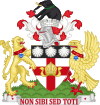Camley Street Natural Park
| Camley Street Natural Park | |
|---|---|
IUCN category IV (habitat/species management area) | |
 | |
| Location | King's Cross |
| Nearest city | London, England |
| Coordinates | 51°32′8.08″N -0°7′41.3″W / 51.5355778°N 0.128139°W |
| Area | 0.8 hectares (2.0 acres) |
| Governing body | London Wildlife Trust |
| www | |
Camley Street Natural Park is an urban nature reserve in King's Cross in central London and within the London Borough of Camden. It is a local nature reserve.[1][2]
Since December 2017, the park has been undergoing reconstruction and has been temporarily closed to the public.[3]
Description

Comprising 0.8 hectares (2 acres) of land on the banks of the Regent's Canal – by St Pancras Lock and adjoining St Pancras Basin, the park is both a sanctuary for wildlife and an educational centre, forming "a lovely oasis".[4]
It is run by the London Wildlife Trust. A visitors' centre caters for casual visitors and school parties, though tours must be booked.
In shape the park is a narrow strip of land bounded by the canal, Camley Street and Goods Way. The entrance is through an ornate gate on Camley Street.
Admission to the park is free. Its opening hours and days change with the funding it is able to win.
Ecology
A variety of habitats co-exist in the park's small environs, including wetlands, meadow and woodland, which attract insects, amphibians, birds, and at least six species of mammal.
Over 300 higher plants have been found at the site; highlights include common broomrape (Orobanche minor), hairy buttercup (Ranunculus sardous) and common spotted orchid (Dactylorhiza fuchsii).[5]
The site is divided into the following habitats:[5]
- A summer-flowering meadow,
- A pond with varying water level, dependent on the canal water level,
- Marshland with reed bed,
- Coppiced woodland,
- Deciduous woodland,
- Mixed woodland with scrub,
- Mixed woodland with hedgerow,
- Dipping pond (with boardwalk),
- Rainwater ponds.
Meadow herbs include white clover and poppy.
Woodland trees include hazel, rowan, hawthorn and silver birch. Hazel and willow are coppiced regularly. Woodland herbs include lesser celandine and wild violet.
Marshland herbs include marsh marigold, greater pond sedge, pendulous sedge, reed, bogbean, mallow and yellow iris. Marsh-nesting birds include reed bunting, moorhen, coot and reed warbler.
History
Until the 17th century the area was in the Middlesex woodlands.[5] In the 18th century it came under industrial use, and the Regent's Canal was built along the eastern edge of the former country estate.[5] In the 19th century the area was used for coal chutes, first for the canal and then for the Midland Railway.[5] Camley Street was originally known as Cambridge Street, until renamed by the LCC. [6] The site became derelict by the 1970s.[5]
In 1984, Camden Borough Council assigned the nascent London Wildlife Trust to manage the site.[5] The park opened in 1985.[5]
In 2008, King's Cross Central started to plan a major development to the east and south of the park, with a footbridge across the Regent's Canal into the park.[7]
Activities
The park hosts pond dipping and wildlife watching sessions for children. Its visitor centre is used by the Wildlife Watch Club.[4]
Value
According to the Mayor of London's Biodiversity Strategy, "Camley Street Natural Park, in particular, has demonstrated that a valuable wildlife space can be created from nothing to become a hub of communal and educational activity, supporting wildlife such as the reed warbler in a place where this would otherwise be unthinkable. Visitors from far and wide come to learn from this example."[8]
See also
External links
References
- ^ "Camley Street Nature Park". Local Nature Reserves. Natural England. 1 March 2013. Retrieved 22 January 2014.
- ^ "Map of Camley Street Nature Park". Local Nature Reserves. Natural England. Retrieved 22 January 2014.
- ^ "Camley Street Natural Park | London Wildlife Trust". www.wildlondon.org.uk. Retrieved 2019-01-18.
- ^ a b "Time Out London". Camley Street Natural Park. Time Out. Retrieved February 2, 2012.
- ^ a b c d e f g h Pashley, James (20 August 2007). "Ecology and Conservation" (PDF). Habitat Management Investigation. James Pashley. Retrieved February 2, 2012.[permanent dead link]
- ^ Names of Streets and Places in the Administrative County of London (4 ed.). London County Council. 1955.
- ^ "King's Cross (Development)". King's Cross - Camley Street Natural Park. King's Cross Central Limited Partnership. 2008. Retrieved February 2, 2012.
- ^ "The Mayor's Biodiversity Strategy" (PDF). Connecting with London's nature. Greater London Authority. July 2002. p. 79. Archived from the original (PDF) on May 16, 2012. Retrieved February 2, 2012.



